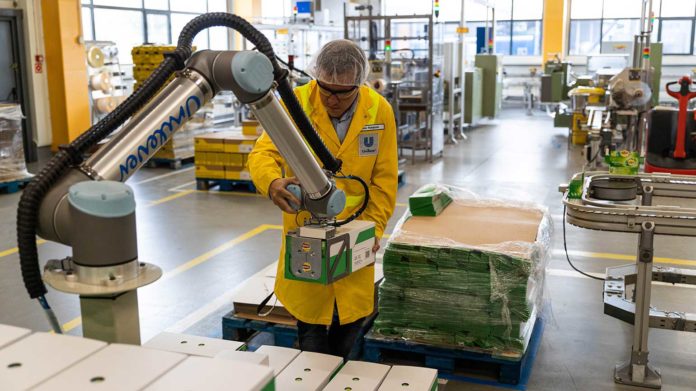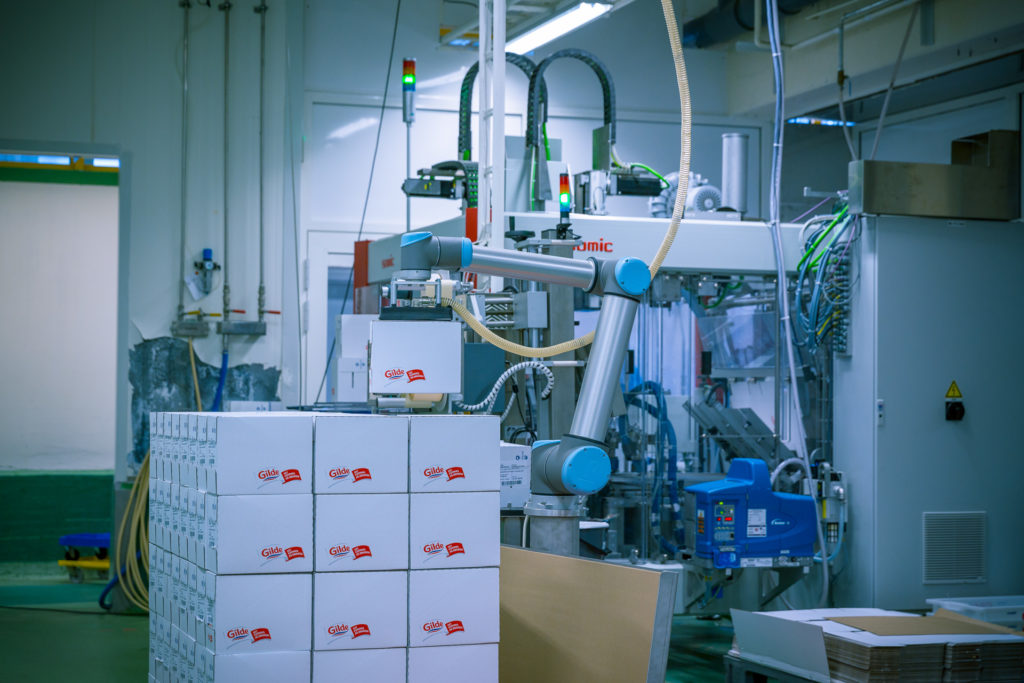
By Joe Campbell, senior manager of applications development, Universal Robots
With small to medium size companies (SMEs) facing labor shortages, supply chain issues, economic uncertainty, and inflation concerns, gaining a competitive edge through smart use of technology is imperative.
The benefits of industrial automation are well-established, compelling, and proven on the ground. Industrial robots improve productivity and throughput, reduce waste, and increase both consistency and quality.
So far, so good, right? Just automate.
Unfortunately for many SMEs spread across the food and beverage sector, automation has historically been too costly to adopt and too complex to be operated and managed in-house.
And while traditional automation has proven adept at handling high volume/low mix (HVLM) production, it isn’t a great match for the small, mixed batch production that is the bread-and-butter business for many SMEs. The good news is that this traditional paradigm, in which industrial automation remains beyond the budgets and capabilities of SMEs, is no longer the complete story.
Today, SMEs can enjoy the benefits of automation without breaking the bank or having to hire teams of robotics engineers. And at the heart of this paradigm shift is a relatively new breed of affordable, easy-to-use industrial robots known as collaborative robots (or “cobots”).
A brief history of cobots
The first commercially viable cobot was launched in 2008 with the promise of providing companies of all sizes with a new breed of industrial robot that combines affordability, versatility, and usability in new ways. On top of that, these new cobots could, after a risk assessment, be deployed safely next to human workers. (Traditional automation, by contrast, requires extensive safety guarding and fencing to keep humans out, increasing the system’s physical footprint and closing off the possibility of human-robot collaboration.)

Just over a decade later, cobots are one of the fastest-growing segments of the industrial robot market, expected to grow at a CAGR of 32.8% between 2019-2024 to reach $1.78 million in global revenues, according to 2021 research from market analysts Frost & Sullivan.
Since 2008, thousands of SMEs in the food and beverage sector worldwide have put collaborative robots to work on tasks from case packing and palletizing to labelling, inspection, and box erecting. But what makes cobots such a compelling proposition for SMEs in particular? And how have cobots transformed traditional automation paradigms?
Here are 5 ways cobots make automation accessible to SMEs.
1. Safety enables collaboration
The traditional automation paradigm separates humans and workers in two fundamental ways: first, by physically fencing off the robot in a guarded cell, and second, by replacing and displacing human labor.
Cobots take a more human-centric approach designed to supplement and enhance manual labor. For example, a cobot erecting cardboard boxes frees up the operator from this repetitive and unergonomic task, enabling the operator to focus on higher-value jobs.
Cobots can be used to completely automate entire processes—a boon for SMEs struggling to fill positions in a demanding labor market—but there are very good reasons for taking a more collaborative, incremental approach. Research has shown that manufacturing processes are faster, more efficient, and more cost-effective when humans and robots work together.
Speed- and force-limiting safety features allow cobots to be deployed close to workers without the need for fencing (following a risk assessment). Safety is at the heart of the cobot value proposition: cobots operate more slowly and carry lighter loads than their traditional industrial robot counterparts. But those small sacrifices in terms of speed and payload deliver all sorts of other value adds for SMEs, from being able to afford automation in the first place to improving ergonomics and enabling effective human-robot collaboration.
2. Removing financial barriers for fast ROI
Traditional industrial robots are expensive to purchase and costly to operate and maintain. If they could afford to purchase a traditional automation system, SMEs with limited or no prior robotics experience would soon become heavily reliant on integrators and engineers to handle product changeovers, programming, and maintenance.
By contrast, the installed cost of a cobot system is less expensive than their industrial robot counterparts, which reduces initial outlay and accelerates ROI. Cobots are also easier to program and maintain using in-house resources, which reduces ongoing operating costs. Some cobot brands provide leasing and financing services, which further lowers the financial barriers to automation adoption for smaller companies.
These factors mean that ROI on a cobot investment can be achieved relatively quickly with typical ROI being measured in months rather than several years, as is often the case with traditional automation.
3. An SME-sized footprint
The traditional industrial robots found in low mix/high volume (LMHV) production environments tend to have a large footprint, which grows even more once safety guarding is added to the mix. This isn’t a problem when an entire facility is dedicated to the production of a limited number of products.
But for SMEs, factory floor space is at an absolute premium. It’s not realistic for SMEs to build their facilities around a single robot. And with more and more companies tending toward HMLV production, it’s just not feasible for SMEs to adopt automation with a large footprint that has to be redesigned and reprogrammed every time a new product is added to the line.
Cobots, by contrast, have a small footprint and, depending on the brand, can be mounted in any orientation: directly on the floor, on carts, on the ceiling or walls, on tracks, on pedestals, and even on mobile robot platforms. Depending on size, a cobot can easily be transported on a dolly by a single worker.

4. Exceptional usability
Learning how to operate traditional industrial robots typically requires extensive onsite training with the robot manufacturer that takes place over weeks and months. Basic cobot training modules can be completed online, and are often measured in hours rather than months. For SMEs with little or no prior robotics experience, usability is one of the most attractive features of cobot technologies.
You don’t need a PhD in robotics to operate cobot systems effectively. Instead of programming your robot via a complex programming language on a user-unfriendly pendant interface, cobots can be programmed via a mix of hand-guiding and intuitive application interfaces on pendants, tablets, and even on smartphones. This means that SMEs can adopt automation without having to rely heavily on integrators and engineers. It also means that operators can be upskilled to take on cobot programming roles.
Remember that not all cobot brands are created equal when it comes to usability. And look for cobot brands that provide extensive education and training resources to support real-world deployments.
5. Building versatility
Since traditional industrial robots tend to have a large footprint, require extensive fencing, and are best suited to LMHV production, they are more often than not relatively static and difficult to redeploy.
Cobots couldn’t be more different. Combining a small footprint and mobility with an ever-growing range of hardware and software tools, cobots are versatile, dynamic automation platforms that can readily be deployed and redeployed on a wide range of applications from material handling and assembly to pick and place and depalletizing.
Here, the differences between brands can be stark. While some cobots are compatible with a limited range of end-of-arm tools, others are compatible with hundreds of different hardware and software solutions. Some brands have created “application kits” that combine a cobot with all the hardware and software required to perform a specific application, further simplifying the deployment process for busy SMEs. Buying into a cobot brand that’s at the center of a larger ecosystem empowers production and futureproofs your cobot investment.
 Joe Campbell is a 40-year veteran of the robotics industry. After executive assignments in sales, marketing, customer service, and operations, Joe is now head of Americas marketing and applications development for Universal Robots. He regularly speaks to industry groups, associations, conferences, and state and local governments on the benefits of robotic automation.
Joe Campbell is a 40-year veteran of the robotics industry. After executive assignments in sales, marketing, customer service, and operations, Joe is now head of Americas marketing and applications development for Universal Robots. He regularly speaks to industry groups, associations, conferences, and state and local governments on the benefits of robotic automation.
All images courtesy of Universal Robots.








